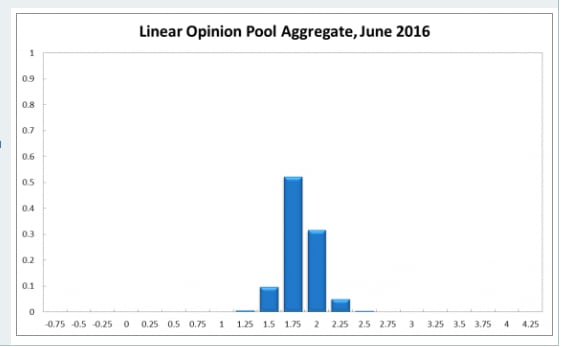The nadir of the interest rate cycle is probably reached: RBA Shadow Board
GUEST OBSERVER
After the Reserve Bank of Australia’s cut the cash rate to 1.75 percent in May due to unusually weak inflation, recent figures show GDP growth, in the March quarter, rose to 1.1 percent, higher than expected.
The unemployment rate remained steady at 5.7 percent, while the global economy continues to paint a motley picture. Relative to last month, the CAMA RBA Shadow Board’s policy preferences have become more hawkish; however, this reflects last month’s divergence between its preferred interest rate setting and the RBA’s actual decision. The Shadow Board attaches a 52 percent probability to a rate hold being the appropriate policy setting. The confidence attached to a required rate cut equals 11 percent, while the confidence in a required rate rise equals 37 percent.
Australia’s unemployment rate stood firm at 5.7 percent. The participation rate remained virtually steady at 64.8 percent. Nominal wage growth at 2.1 percent year-on-year is the lowest it has been in 18 years, reflecting slackness in the labour market and a replacement of high-wage jobs in the mining industry with lower paying jobs elsewhere in the economy.
Last month’s rate cut pushed the Aussie dollar four cents lower, relative to the US dollar; it is trading between 72 US¢ and 73 US¢. For the same reason yields on Australian 10-year government bonds have fallen to under 2.3 percent.
Domestic share prices rose to new highs. The S&P/ASX200 last week closed above 5400, the highest since August 2015. Global stocks markets have been similarly buoyant.
Australian GDP growth was unexpectedly high in the first quarter of 2016, clocking in at 1.1 percent, compared to 0.7 percent in the previous quarter. At this rate, annual GDP growth for the 201⅚ fiscal year will equal around a healthy 3 percent.
The US economy is continuing to grow near potential but the most recent unemployment figures disappointed. Other countries are faring less well. Russia is hoping its economy will start growing again later this year while Brazil just announced its economy contracted by 5.4%, year-on-year, in the first quarter. China’s growth rate is expected to be between 6 percent and 7 percent; recent announcements by the Chinese government of large-scale infrastructure projects are no doubt meant to breathe new life into the Chinese economy. Europe’s economies are expanding modestly, Japan is standing still and there remains uncertainty surrounding the resilience and strength of the world’s developing economies, especially those carrying large debt burdens.
Consumer confidence, as measured by the Westpac/Melbourne Institute Consumer Sentiment Index, leapt from 95 in April 2016 to 103 in May. Business confidence, according to the NAB business survey, fell slightly from 6 to 5 in April. The AIG manufacturing index fell slightly, but the services index, also a leading economic indicator, rose.
The Shadow Board’s confidence measures have shifted considerably. It attaches a 52 percent probability (63 percent last month) that “no change” is the appropriate policy, an 11 percent probability (29 percent last month) that a rate cut is appropriate and a 37 percent probability (8 percent in the previous month) that a rate rise, to 2.00 percent or higher, is appropriate.
It must be borne in mind, however, that the Shadow Board, in contrast to the RBA which lowered the cash rate last month, preferred to keep the cash rate on hold in May. Hence, the current probabilities overall reflect a more hawkish stance relative to the RBA.
The probabilities at longer horizons are as follows: 6 months out, the estimated probability that the cash rate should remain at 1.75 percent equals 24 percent (29 percent in May). The estimated need for an interest rate decrease has fallen from 29 percent to 16 percent, while the need for a rate increase has risen 18 percentage points to 60 percent. A year out, the Shadow Board members’ confidence that the cash rate should be held steady equals 14 percent (19 percent in May), while the confidence in a required cash rate decrease equals 16 percent (19 percent in May) and in a required cash rate increase 70 percent (61 percent in May).

For more information, click here.
